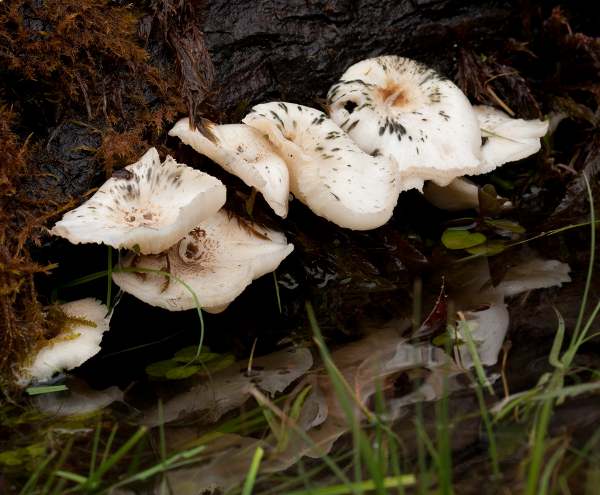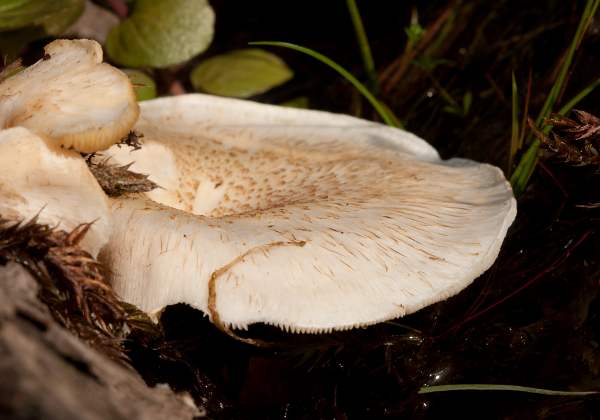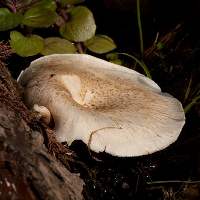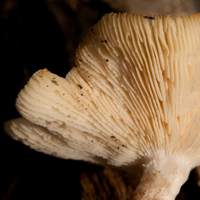Trees Birds Mammals Fish Amphibians Reptiles
Wild Algarve
Bookshop
Lentinus tigrinus (Bull.) Fr. - Tiger Sawgill
Phylum: Basidiomycota - Class: Agaricomycetes - Order: Polyporales - Family: Polyporaceae
Distribution - Taxonomic History - Etymology - Identification - Culinary Notes - Reference Sources

An uncommon to rare find in Britain and Ireland, the Tiger Sawgill grows on waterlogged rotting branches of deciduous hardwood trees, particularly willows.
Distribution
Lentinus tigrinus is seen only infrequently in Britain, mainly from central and southern England. It occurs also across most of mainland Europe and in parts of Asia as well as North America.
Taxonomic history
The Tiger Sawgill was first described scientifically in 1782 by the pioneering Frency mycologist Jean Baptiste Francois Pierre Bulliard, who gave it the binomial scientific name Agaricus tigrinus. It was the Swedish mycologist Elias Magnus Fries who, in 1825, redescribed this species and transferred it to the genus Lentinus, thus establishing its currently-accepted scientific name Lentinus tigrinus.
Synonyms of Lentinus tigrinus include Agaricus tigrinus Bull., Agaricus dunalii DC., Omphalia tigrina (Bull.) Gray, Clitocybe tigrina (Bull.) P. Kumm., Pocillaria tigrina (Bull.) Kuntze, Panus tigrinus (Bull.) Singer, and Pleurotus tigrinus (Bull.) Kühner.

Etymology
The generic name Lentinus means comes from the Latin Lent-, meaning pliable, and -inus, meaning resembling; so Lentinus means 'resembling pliable'. The specific epithet tigrinus means 'like a tiger', and refers to the scaly stripes on the cap and often also the stem of this mushroom.
Identification guide
 |
Cap
1 to 8cm across; umbilicate to deeply funneled; whitish to buff or pale tan with matt black or brown radial scales; margin often downturned or slightly inrolled when young, sometimes flattening at maturity. Flesh white or yellowish, tough and and firm.
Stem
Centrally attached or sometimes slightly excentric, 2-5mm in diameter and 2 to 4cm long; initially smoothish or scaly as the cap, with an ephemeral ring zone. |
 |
Gills
White or yellowish; decurrent, crowded, dentate (toothed) or serrate. |
| |
Spores
Cylindrical to narrowly ellipsoidal, smooth, 6-10 x 2-3µm; inamyloid
Spore print
White. |
Odour/taste |
Odour faint, fruity; taste mild, mushroomy but not distinctive. |
Habitat & Ecological role |
Saprobic, usually found in clusters on willows (Salix spp.) or poplars (Populus spp.) in carr woodland (permanently very wet woodland which, in Britain at least, is usually dominated by low-growing willow and alder tree species) or low down on riverbank willows. |
Season |
Summer and autumn. |
Similar species |
Dryad's Saddle, Polyporus squamosus, occasionally forms trumpet-shaped fruitbodies arising from roots under the leaf litter; however, it has a black stem base and pores rather than gills. |
Culinary Notes
The tough thick caps are reported to be edible, but in Britain this is an uncommon or rare find, due at least in part to the difficulty of access to the inhospitable wet-woodland habitats in which it occurs.
Reference Sources
Pat O'Reilly (2016). Fascinated by Fungi, First Nature Publishing
BMS List of English Names for Fungi
Paul M. Kirk, Paul F. Cannon, David W. Minter and J. A. Stalpers. (2008). Dictionary of the Fungi; CABI.
Taxonomic history and synonym information on these pages is drawn from many sources but in particular from the British Mycological Society's GB Checklist of Fungi.
Acknowledgements
This page includes pictures kindly contributed by David Kelly.
Top of page...
Fascinated by Fungi. Back by popular demand, Pat O'Reilly's best-selling 450-page hardback book is available now. The latest second edition was republished with a sparkling new cover design in September 2022 by Coch-y-Bonddu Books. Full details and copies are available from the publisher's online bookshop...